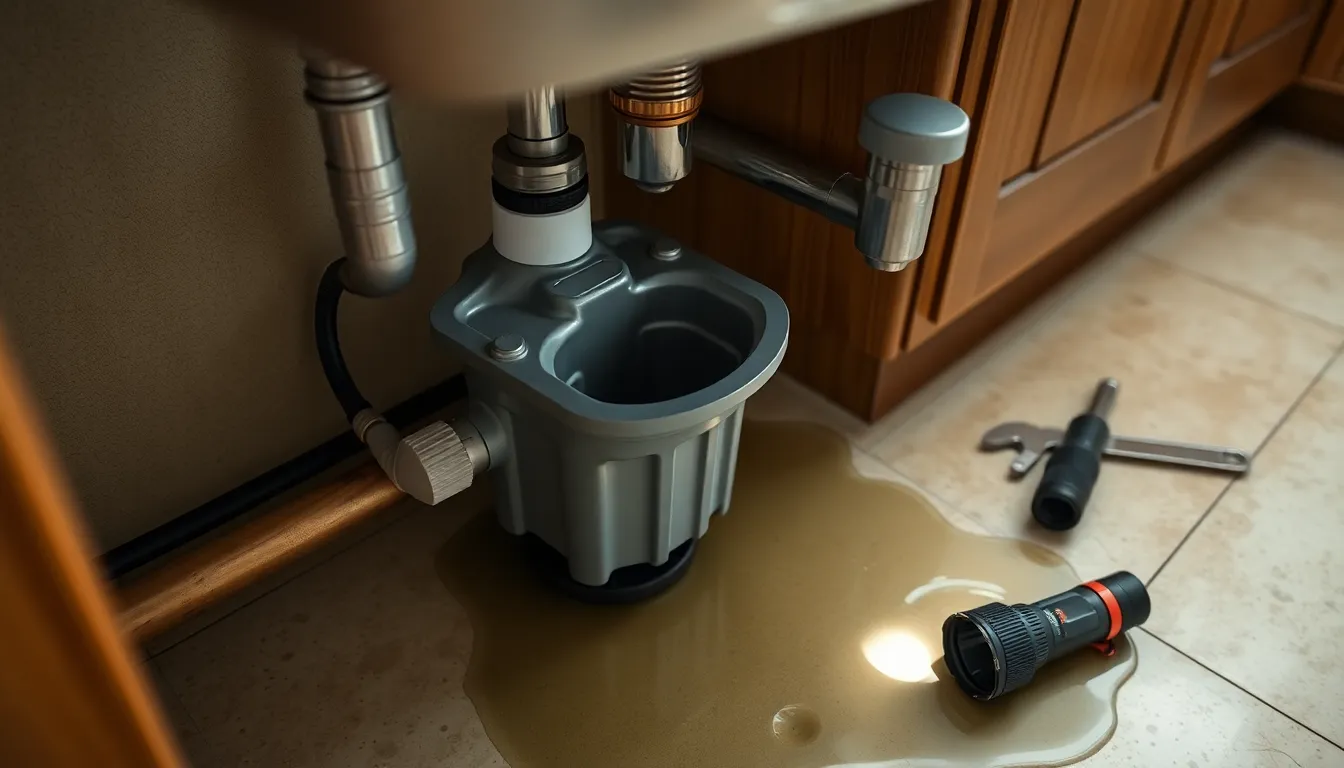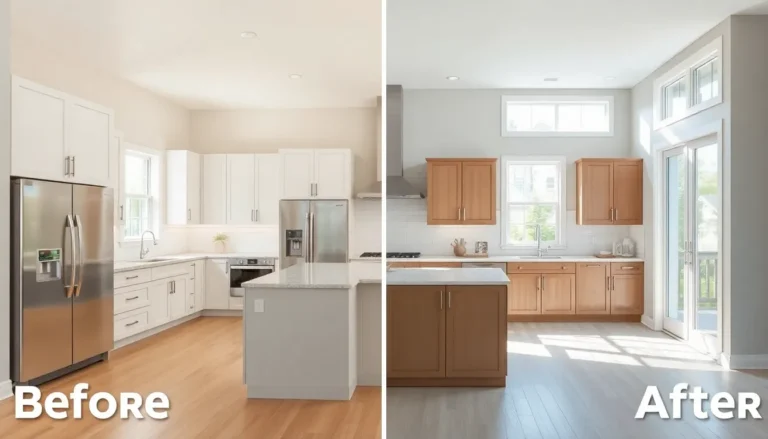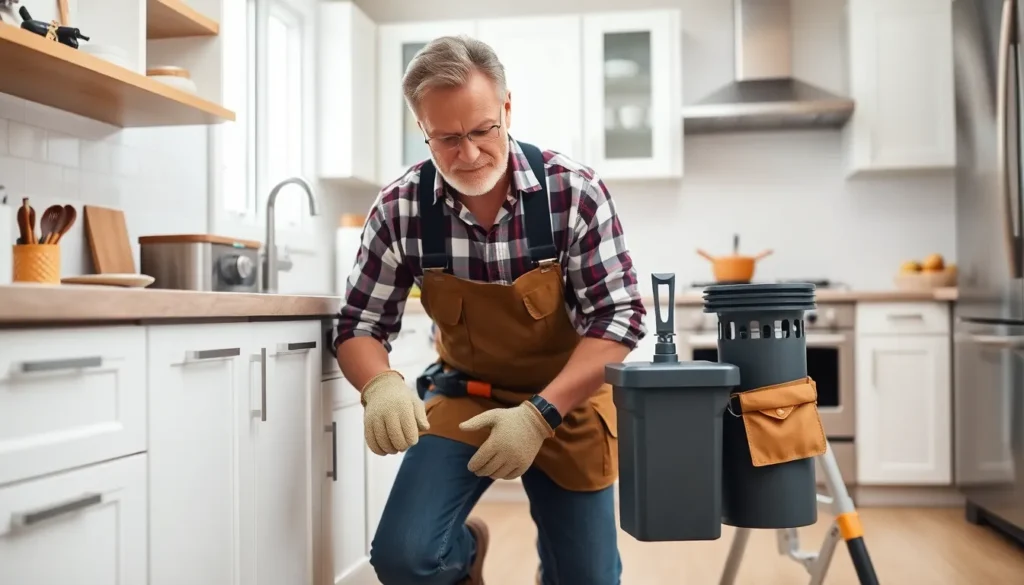Table of Contents
ToggleA malfunctioning garbage disposal can turn a simple kitchen task into a major headache. When it stops working, it often leaves homeowners feeling frustrated and unsure about how to fix the problem. Understanding the common issues and repair methods can save time and money while keeping the kitchen running smoothly.
From clogged drains to motor failures, garbage disposal problems can arise unexpectedly. Knowing the signs of trouble and when to call in a professional can make all the difference. With the right approach, many repairs can be tackled with just a few tools and some basic knowledge, empowering homeowners to take control of their kitchen maintenance.
Understanding Garbage Disposal
Garbage disposals are essential kitchen appliances that help manage food waste efficiently. Understanding their functionality and types can facilitate effective maintenance and repairs.
What Is a Garbage Disposal?
A garbage disposal is a device installed under a kitchen sink, designed to shred food waste into small particles. It connects to the home’s plumbing, allowing the waste to flow easily through the drainage system. The primary components include a motor, grinding chamber, and a splash guard. When food waste enters the chamber, the motor activates, spinning the blades to break down the waste into tiny pieces. This process reduces landfill waste and promotes sanitary waste management.
Common Types of Garbage Disposals
Common types of garbage disposals include:
- Continuous Feed Disposals: Operate while the switch is on, allowing waste to be added continuously. They’re popular for their convenience and ease of use.
- Batch Feed Disposals: Activate when a cover is in place, requiring users to load waste in batches. This type enhances safety, preventing accidental activation.
- Evolution Series Disposals: Feature advanced grinding technology for quiet operation and enhanced efficiency. Suitable for households with heavy waste disposal needs.
- Commercial-Grade Disposals: Designed for high-volume use in restaurants and commercial kitchens. These disposals handle larger food waste quantities and offer powerful grinding capabilities.
Understanding these types helps in selecting the right disposal for specific kitchen needs and planning maintenance or repairs effectively.
Common Problems with Garbage Disposals

Garbage disposals can encounter several common issues that may disrupt their functionality. Identifying these problems early can help in addressing them efficiently.
Clogs and Jams
Clogs and jams rank among the most frequent problems with garbage disposals. Blockages can occur due to food debris, fibrous materials, or large items being fed into the unit. Signs of a clog include slow drainage or a complete halt in operation. Clearing a jam often requires turning off the power to the disposal, using an Allen wrench to manually spin the motor, and removing any visible obstructions before restarting. Regularly running water and only disposing of approved food items can prevent these issues.
Leaks and Water Damage
Leaks can lead to significant water damage under the sink. Common causes of leaks include loose connections, deteriorated seals, or cracks in the disposal unit. Identifying a leak can involve checking for water pooling underneath the unit or noticing dampness in surrounding areas. Tightening connections or replacing seals can often remedy minor leaks, while damaged disposals may require full replacement. Regular inspections help catch potential issues early.
Unusual Noises
Unusual noises typically indicate a problem within the garbage disposal. Sounds such as grinding, rattling, or humming can suggest foreign objects lodged in the blades, dull blades that require sharpening, or electrical issues. Strange noises warrant immediate attention to prevent further damage. Checking the disposal for foreign items, ensuring the motor is not straining, and considering professional assistance help in resolving noise-related problems effectively.
Steps for Garbage Disposal Repair
Garbage disposal repair involves a series of actionable steps to ensure safe and effective troubleshooting. Following these steps can help homeowners resolve common disposal issues efficiently.
Safety Precautions
- Turn Off Power: Unplug the garbage disposal or switch off the circuit breaker supplying power to it.
- Use Safety Gear: Wear gloves and safety goggles to protect against sharp objects and debris.
- Avoid Water: Ensure the area around the disposal is dry to prevent electric shock during repairs.
Diagnosing the Issue
- Inspect for Jams: Look for any visible obstructions in the disposal that may cause it to jam, such as food particles or utensils.
- Listen for Sounds: Pay attention to any unusual noises, which might indicate internal damage or foreign objects.
- Check for Leaks: Examine the disposal and surrounding plumbing for signs of water leaks or deterioration in seals.
Fixing Common Problems
- Clearing Clogs: Use a hex wrench to manually turn the motor, dislodging any jams. Remove any obstructions found in the disposal.
- Tightening Connections: Check and tighten any loose mounting bolts or drain connections to prevent leaks.
- Resetting the Unit: If the disposal hums but won’t run, press the reset button located on the bottom of the unit. This can often resolve minor electrical issues.
When to Call a Professional
Knowing when to call a professional for garbage disposal issues can save time and prevent further damage. Homeowners should look for specific signs that indicate expert assistance is necessary.
Signs You Need Expert Help
- Continuous Jams: If the disposal frequently jams despite manual attempts to clear it, a mechanical issue may exist.
- Persistent Leaks: Ongoing leaks that don’t respond to tightening connections or replacing seals require professional expertise to assess the unit’s condition.
- Unusual Noises: Grinding, rattling, or clicking sounds indicate possible foreign objects or electrical malfunctions needing immediate service.
- Power Issues: An inability for the unit to power on, even after resetting, signals electrical faults requiring a certified technician.
- Foul Odors: Lingering smells despite cleaning efforts may point to trapped debris or clogs within the system that warrant thorough inspection.
Choosing the Right Repair Service
- Certification: Select a service provider certified in plumbing or appliance repair to ensure qualified expertise in garbage disposal repairs.
- Experience: Choose a company with a proven track record in appliance repair, particularly with garbage disposals, to increase the likelihood of successful resolution.
- Reviews and Referrals: Check online reviews and seek recommendations from trusted sources to identify reputable professionals.
- Service Guarantee: Look for a service that offers guarantees on repairs, providing peace of mind and assurance of quality work.
- Transparent Pricing: Opt for a repair service that provides clear, upfront pricing to avoid unexpected costs during the repair process.
A well-functioning garbage disposal is essential for maintaining a clean and efficient kitchen. By understanding common issues and their solutions homeowners can tackle minor repairs with confidence. Regular maintenance and inspections can prevent many problems before they escalate.
When faced with persistent issues or complex repairs knowing when to call a professional can save time and ensure proper resolution. With the right knowledge and tools homeowners can keep their garbage disposals running smoothly while enjoying the convenience they provide in daily life.





